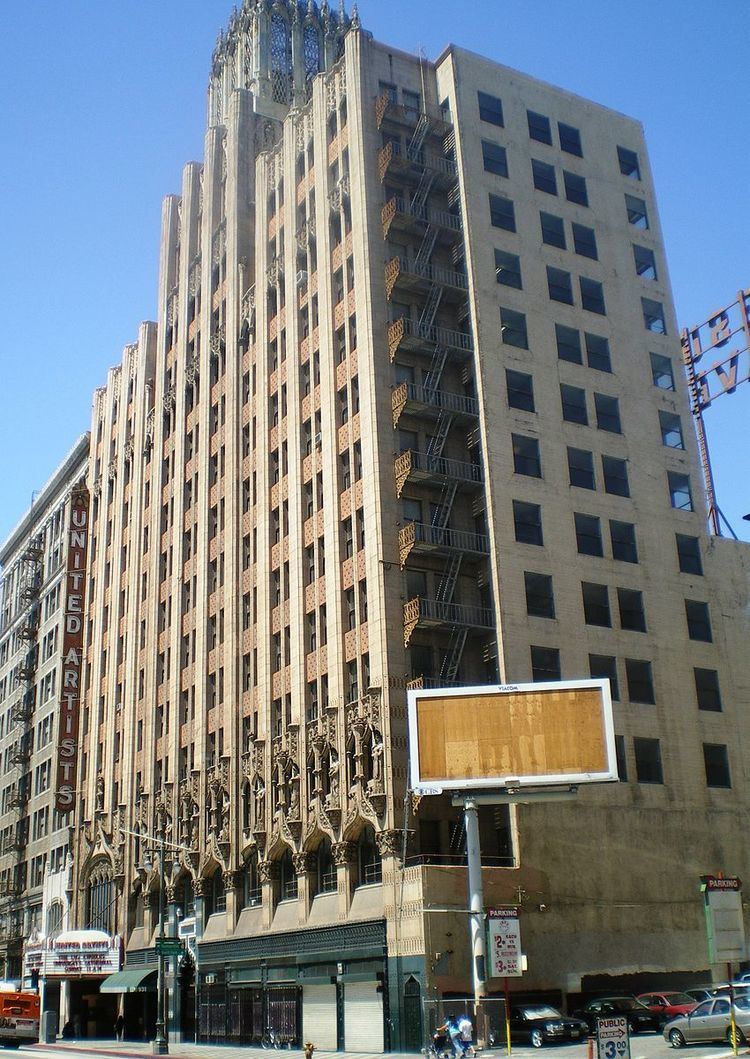Status Complete Completed 1927 | Type HotelTheater | |
 | ||
Owner Chesapeake Lodging Trust | ||
Ace Hotel Downtown Los Angeles, originally built as the United Artists Building and later known as the Texaco Building, is a 243 ft (74 m), 13-story highrise hotel and theater building located at 937 South Broadway in downtown Los Angeles, California. It was the tallest building in the city for one year after its completion in 1927, and was the tallest privately owned structure in Los Angeles until 1956. Its style is Spanish Gothic, patterned after Segovia Cathedral in Segovia, Spain.
Contents
- United Artists Theater
- Los Angeles University Cathedral period
- Ace Hotel conversion
- Broadway Theater Historic District
- References
The building contains the historic United Artists Theater, the flagship theater built for the United Artists motion picture studio. The theater was later used as a church by pastors Gene Scott and his widow Melissa Scott under the name "Los Angeles University Cathedral". In October 2011, Scott's Wescott Christian Center Inc. sold the building to Greenfield Partners, a real estate investment company located in Westport, Connecticut, for $11 million. It was converted to a hotel, and opened in 2014.
United Artists Theater
The United Artists Theater was designed by the architect C. Howard Crane of the firm Walker & Eisen for the United Artists film studio formed by D. W. Griffith, Charlie Chaplin, Douglas Fairbanks and Mary Pickford. The theater, a classic movie palace, was one of many constructed by United Artists and served as a major premier house. The theater occupies three floors of the 13-story building and has a 1,600-seat auditorium. Like many movie theaters, the seat rows sink in toward the front of the orchestra section, so ticket holders there must look up at the stage.
Los Angeles University Cathedral period
The building was first leased by Gene Scott in 1989, to be used as the location from which to broadcast the live Sunday services of his ministry. Scott held his first Sunday service there in 1990 and continued to hold Sunday services there until his death in 2005. A designated historic monument in itself, the building was for many years topped by the historic "Jesus Saves" neon signs (originally from the Church of the Open Door). They were located in the rear lower roof, one facing the west and one north, until September 10, 2011, when one sign was removed by crane. The building was claimed to house the largest collection of Bibles in private hands. After leasing for thirteen years, Gene Scott purchased the building in 2002. Following Scott's death, services continued to be held at the Los Angeles University Cathedral by Melissa Scott, the widow of Gene Scott, with services broadcast over TV, shortwave radio, and the Internet.
Ace Hotel conversion
The building has been completely restored and renovated to serve as a luxury boutique hotel called Ace Hotel Downtown Los Angeles. It features 182 rooms, a pool, a restaurant and three bars, as well as the restored United Artists Theater. It opened in January 2014. In December 2014, Greenfield Partners put the building up for sale, seeking about $100 million as the sale price. In May 2015, Chesapeake Lodging Trust bought the building for $103 million.
The theater was restored as well and re-opened with concerts by the British rock band Spiritualized. L.A. Dance Project, a dance company founded by choreographer Benjamin Millepied, will also take residence in the Theatre at Ace Hotel.Red Hot Chili Peppers performed a fundraiser at the Ace Hotel on February 5, 2016 in support of presidential candidate Bernie Sanders.
Broadway Theater Historic District
The building is a historic district contributing property in the Broadway Theater District on the National Register of Historic Places. It is also a Los Angeles Historic-Cultural Monument.
